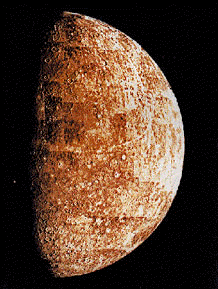This diagram shows the internal structure of the planet Mercury. Scientists believe that the core of Mercury is hot, liquid iron-nickel. Mercury has no atmosphere and as a result, the surface is pocked by craters from collisions with asteroids over billions of years.
Click on image for full size
Windows Original.
Structure of Mercury's Interior
Mercury has a radius of 2439 km (1524 mi), and the metallic
iron-nickel core is believed to make up about 75% of this distance.
Measurements of the planet's magnetic field made by Mariner 10 as it
flew by the planet indicates that this core is likely to be hot and fluid.
In contrast with the other terrestrial planets, the rest of the
planet is probably made up of a solid rocky layer topped with a thin
crust about 100 km thick. The
surface of Mercury is
covered with a variety of craters formed from the impact of meteorites
billions of years ago and other features that reveal information
about the
evolution of the
planet.
You might also be interested in:

How did life evolve on Earth? The answer to this question can help us understand our past and prepare for our future. Although evolution provides credible and reliable answers, polls show that many people turn away from science, seeking other explanations with which they are more comfortable.
...more
Images of the surface of Mercury obtained by Mariner 10 showed a planet covered with craters, looking very much like the Earth's Moon. During its three passes by the planet, Mariner 10 took pictures of
...more
Mercury, like the other planets, is believed to have formed in the earliest stage of the evolution of the solar system as dust came together to form even larger clumps and eventually small planets or
...more
Mercury, the innermost planet of the solar system, is a little bigger than the Earth's Moon. The surface of the planet is covered with craters, like the Moon, but temperatures there can reach over 80
...more
Mercury has a radius of 2439 km (1524 mi), and the metallic iron-nickel core is believed to make up about 75% of this distance. Measurements of the planet's magnetic field made by Mariner 10 as it flew
...more
The Caloris Basin is the largest feature on the surface of Mercury. This crater was formed by the impact of a large meteorite near the end of the period of frequent impact cratering in the early solar
...more
A wide variety of craters ranging in size from 100 meters to 1300 km across can be seen in the Mariner 10 images of Mercury's surface. These include: (1) craters in young terrain, (2) double craters,
...more
The surface of Mercury has numerous interesting features, including a variety of craters, ridges, and terrains ranging from heavily cratered to nearly crater free. These features, and their distribution
...more













